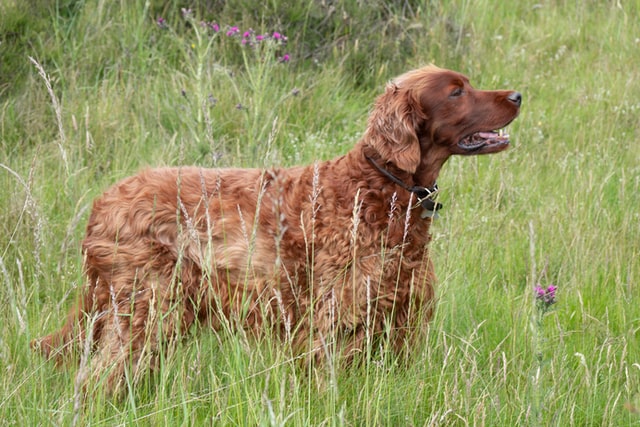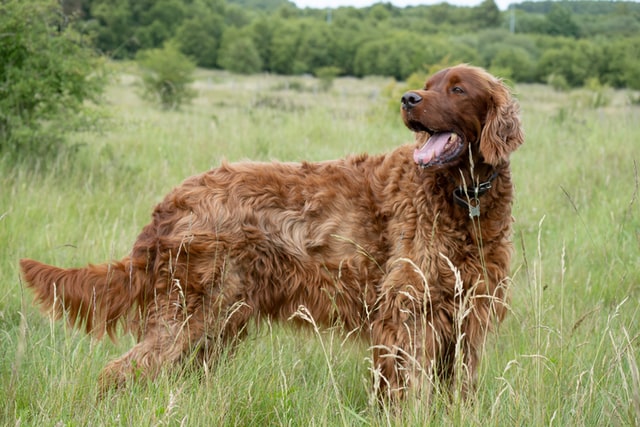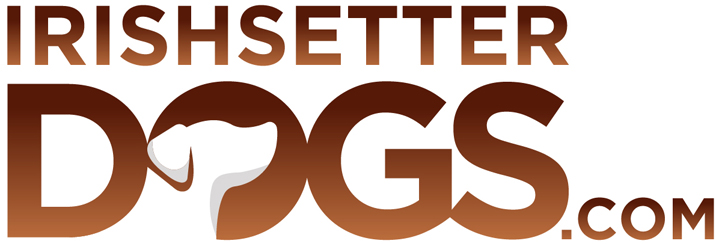Have you ever considered the factors that make an Irish Setter an excellent choice to bring to your home? One of these factors would be the Setter’s size and growth rate since it can be directly affected by the space you have available. In this article, we will be talking about the size of a well-known dog and help you contemplate whether you should get this pup or not. If the title hasn’t made it obvious enough, the Irish setter is the specific dog breed we will be talking about. So, how do big Irish Setters affect your daily life?
The Irish setter is a well-known large dog breed. They were initially bred as hunting companions, but they have become one of the most popular family pets in the world in recent years. However, if you consider getting an Irish setter, it’s essential to understand how big they get and how their size can impact your life. So, without further ado, here’s everything you need to know about how big Irish setters get:
🐶 IRISH SETTER FOR YOUR FAMILY 🐶

With all the positive encouragement to get an Irish Setter, you still need to know what are the negative effects of having a Setter on your family. But take note, this section’s goal is not to stop you from getting one! This is just to show you all the possibilities so that it will not be surprising for you in case your Setter will manifest one of the cases below.
Let’s start!
🟩 Overexcitement
Though it has been said from the previous blogs that Irish Setters are an excellent family pet, there are still consequences in bringing them home. Along with their energy, Irish setters also tend to get overly excited, which may lead to accidents with smaller pets and children. Your Setter may unintentionally pounce or come into vigorous contact with children, leading to injuries for both the Irish setter and the child.
However, this you can solve this behavior with proper training and socialization, which the Irish setter will need at a young age. They require a lot of pampering and attention, so if you don’t have the time to devote to them regularly, they may not be suitable for your family.
🟩 Exercise
Secondly, Irish setters have a very high energy level, and they require a lot of exercises. These Setters prefer to play outside (as most dogs do), so you will have to provide them with a large amount of yard space. Irish Setters, as a breed, can be big and aren’t great for owners who do not have a place to exercise them regularly. So it’s best to look into other options if you do not have time to prepare for that kind of presence in your home or apartment.
🟩 Food and location
These Setters also eat between 2 and 3 cups (about 300 grams) of food per day, depending on their age. Their specific food measurements will allow them to have more energy while playing. As mentioned above, you’ll need room outside to play as well, such as a yard of at least half an acre (more than one-third hectare). This is the minimum size required for this type of dog. If you live somewhere where there isn’t any land available but still want an Irish setter puppy or an older dog, consider getting one from a local shelter.
🟩 Territorial comfort
Though you can train Irish Setters at a young age, there’s still a tendency that they can grow to be territorial. Because Irish setters are so large, they are not excellent for people with tiny homes, yards, or budgets. This is because a giant dog will likely need more space to fit in your home comfortably. As you may have already known, some Setters prefer to have a specific part of the house as their “territory” as a part of their primal instinct. Having limited space limits this territory, leading to behavioral issues if you have visitors or outsiders that the Irish setter may see as a threat to their territory.
🟩 Behavioral origin
Irish Setters were bred as hunting companions. You know they behold if you’ve ever seen one of these dogs in action. They’re fast, graceful, and brilliant that’s why they were initially bred to hunt by sight and not by sound. This made them ideal for tracking birds in the countryside since they would hear them coming long before the Irish Setter could get within range of making any noise itself (even if it was just sniffing around).
The Irish Setter can also be very friendly with people and other dogs, a trait that makes it a great family pet (on a positive note)!
🐶 IRISH SETTER SIZE 🐶
If you are wondering what are the factors that affect your Irish Setter’s size, you’re in the right section! Here are things that can be blamed for why your Irish Setter keeps on growing.
🟩 Depends on the breed
The size of an Irish setter can also depend on which pedigree it has. The American Kennel Club (AKC) recognizes three different sizes for Irish setters: Large, Medium, and Small. However, these don’t consider size variations between different bloodlines.
The breeders you can buy from should be licensed and certified by a kennel club to ensure that their dogs are ethically bred. This will ensure the safety of your Irish Setter in terms of health condition, life expectancy, and other things that are effects of unethical breeding.
🟩 Depends on sex
When it comes to determining how large and heavy a Setter puppy will be as an adult, several factors determine size: the breed, lineage, and gender.
Male Irish setters will grow to be larger than female Irish setters. They’re genetically programmed to be bigger and more muscular than females. On average, male Irish setters are about 20% larger in stature than females, and sometimes even more so! Male Irish setters also tend to weigh more than females of their breed: by more than 20%.
Another fun fact is that male Irish setters are taller than females by about 20%. This means that any time you’re trying on clothes or shoes for your Setter puppy and find something that fits perfectly but looks ridiculous on them, you can blame this difference in size between males and females for ruining your fashion sense. Of course, these percentages vary depending on what part of the country you live in (and whether you have one dog or two).
🐶 GROWING AGE PEAK 🐶

It may be a surprising case to see such a small puppy grow up exceptionally fast in its first year. A full-grown Irish Setter will weigh between 75 and 85 pounds. These pups are large and energetic, so they need a lot of exercises (a long walk every day should do it). They also need to eat high-quality dog food that provides plenty of protein, calcium, and other nutrients that help support their big bodies.
Besides dog food, they are also likely to have probiotics and supplements from their vet if they are physically fit enough to receive them. As an owner, you should also expect a lot of expenses during the first year because of vaccinations and other treatments like deworming. You may visit your vet every month or every few weeks to conduct early tests and screenings for many common health issues your Irish setter may have.
🐶 KEEPING THEM HEALTHY WHILE GROWING 🐶
Some may gloss over responsibility as pet owners keep their pets at a healthy weight. To do this, you’ll need to feed them a high-quality diet that meets their nutritional needs and restrict treats and table scraps. It’s essential to remember that dogs’ bodies respond differently from humans’, so what we eat may not be suitable for our furry friends.
A general rule is to feed your Setter a diet appropriate for their age, size, and activity level. For example: if your dog is an adult with little exercise, then it probably doesn’t need as many calories as an energetic puppy or elderly pet would need on any given day; nor does it require an equal amount of vitamins/minerals such as calcium or vitamin B12 found in meat sources (which could be harmful).
Finally, and this one should go without saying, don’t ever let your dog binge on human food! It can lead right back down the path toward health problems like Diabetes because they’re getting too much sugar or fat into their system all at once, which may cause inflammation throughout different parts of their body over time.
🟩 Diet tips
Knowing what to feed and not feed your Irish setter can contribute significantly to their growth and overall health. Below are some things you should avoid when providing your Irish setter:
>>Avoid feeding your dog too much food.
Follow the recommended rations by your Irish setter’s vet. Though there are general amounts you can follow, it will still depend on your dog’s activity level, health condition, and age. To get the most optimal dose, you can consult your vet or look for an animal nutritionist.
>>Avoid feeding your dog too many treats.
There is a ratio that most pet owners follow to calculate how many treats a dog can have per day. Ten percent of your Irish setter’s daily calories can be present for treats (preferably while minimizing treats with high amounts of sugar).
>>Avoid feeding your dog too many human foods.
Human food may contain certain regular ingredients (such as onion and garlic) that can be unhealthy and even detrimental to your Irish setter’s weight. Some foods may also include more significant amounts of calories that will be harder to burn for the dog, especially if it has lower energy levels (or in its senior years).
>>Avoid feeding your dog too many table scraps and leftovers.
A general rule to consider is to avoid feeding leftovers to your dog as much as possible. Some portions, especially those refrigerated or preserved for a long time, can be harmful to your Irish setter.
🐶 GROOMING COST OF BIG IRISH SETTER 🐶
Large dogs like Irish Setters require more frequent grooming than small dogs, so you’ll have to spend more on a quality brush, shampoo, and other tools for the job. But don’t worry—there are ways to save money on grooming.
🟩 More fur, Higher cost
Of course, let us not forget that bigger dogs tend to have more fur. Though Irish setters do not shed as much as other large dogs, it is inevitable to see fur scattered around your floor coincidentally the same color as your dog’s coat (definitely not a coincidence!).
🟩 Saving tips
First, look for a groomer who offers discounts for first-time customers or those who pay cash upfront. You can also try using coupons from your local pet store or checking out apps like Groupon and Living Social that offer deals on dog care services in your area (and there are lots of them). You might even find a groomer willing to do discounted or free grooming sessions if they were friends or family members of yours before they started working as dog groomers themselves!
🟩 Home grooming
If none of these options work out adequately enough for your budget, consider learning how to do it yourself! Grooming kits are very affordable nowadays, so check out some online reviews before buying one so you know what’s best for keeping fur healthy while reducing shedding.”
🐶 HOUSE CONSIDERATIONS FOR BIG IRISH SETTERS 🐶

A large Irish Setter can exceed an area of 100 square feet in the house, which is approximately the size of a studio apartment. If you live near or in an urban area, your home may be smaller, but make sure your pet has safe places to exercise.
Large Setters require a reasonable amount of room: 50-100 square feet outdoors should be enough space for them to walk around and play with toys, while indoors, they need space to run around freely after having an all-day training. Larger breeds that tend to grow more quickly (such as the Irish Setter) will also need adequate room, so their bones don’t become deformed from lack of activity or overuse when it comes time for their growth spurt!
🟩 Checklist
So if you want an Irish setter, you should start assessing your situation first. You should be able to have an answer to the following questions:
- Do I have enough vacant space in my house for a large dog?
- Will I be able to handle the expenses needed for the dog’s well-being, all while still being able to live comfortably?
- Can I dedicate enough time and energy to play and give attention to the dog I’ll be getting?
If you happen to answer “no” to any of these questions, then it is advisable that you stabilize your situation first before getting an Irish setter. Ignoring these can lead to unfavorable conditions for you and the dog you will be getting. Irish setters are a long-term commitment, which means you can become stuck with them for 12-15 years with these conditions.
🟩 Apartment community
Even if you’re a responsible, kind dog owner who wants to ensure that your dog is going to be safe, there are still a few factors that can hinder your chances of finding an apartment community willing to take him in.
Many apartment communities have size limits on pets that live in their buildings. There are also breed restrictions, which may keep your Irish Setter out even if he meets all other requirements. Some communities have weight limits as well—the heavier, the better! And finally, some communities only allow dogs under a certain age (usually less than six months).
In short: unless you live alone or with someone willing to move into another place just for this pup, consider checking out how big do Irish setters get before buying one or adopting one from AKC registered shops because it’s probably not worth trying for now at least until he grows up a bit more.
🐶 LIFE EXPECTANCY AND RISKS 🐶
If you’re the type of person, who wants to take your dog on long walks or go running with it every day, or even play fetch in the backyard for hours, Then you might want to consider getting a smaller breed. Bigger dogs don’t just have bigger hearts; they also have more body mass that needs to be supported by those hearts (and legs).
This means that larger dogs may not live as long as smaller ones. Larger breeds are more likely to develop joint problems during their lives and heart disease at an earlier age than smaller dog breeds. They also face higher risks of obesity and diabetes, leading to shorter lifespans than their smaller counterparts.
Irish setters are prone to various conditions as they grow older. This makes them exceptionally costly to take care of, considering the size they will already be occupying in your home. Some of these conditions will be talked about in the next section of this article.
🐶 HEALTH ISSUES WHILE GROWING 🐶

Like most dog breeds, Irish setters can be affected by various conditions, which they will become increasingly prone to in their senior years. Some of their common diseases will be listed down below:
🟩 Retinal Atrophy
This is a condition wherein the Irish setter will progressively succumb to blurry vision and can eventually lead to blindness. The disease affects the photoreceptor cells in the dog’s eyes, causing them to deteriorate slowly and over time until enough cells have died out to hinder the eyes from seeing.
🟩 Hip Dysplasia and Arthritis
These are both conditions that can trigger one another. They will usually occur around the Irish setter’s pelvic and leg area, eventually causing the dog’s joint to deteriorate or separate. This can hinder the dog’s ability to walk, and the effects of these conditions can be excruciating for the Irish setter if left untreated. Due to their large size and weight, such physical characteristics can further escalate these conditions.
🟩 Autoimmune Thyroiditis and Hyperthyroidism
These are conditions that affect the Irish setter’s thyroid gland. Both diseases can be deadly, but the main difference between them is that autoimmune thyroiditis is almost instantaneous and an emergency case. At the same time, hyperthyroidism can harm the dog over time by causing cancer cells to thrive in the thyroid area.
🟩 Epilepsy
Epilepsy can cause violent seizures that can lead to death without proper treatment. Different stimuli can trigger epilepsy, but you have to monitor your pup if it has this condition and you also have to keep it away from its triggers to prevent episodes.
🟩 Leukocyte Adhesion Deficiency
LAD renders the Irish setter’s immune system weakened and makes it prone to infection. Vets can usually treat this condition by drastic measures such as a bone marrow transplant to increase the number of healthy leukocytes.
🟩 Obesity and Diabetes
These are both due to an unhealthy and unbalanced diet which you, as the owner, are responsible for. However, Irish setters, being large dogs, are especially prone to these conditions due to their size, appetite, and genetics. Fortunately, they have high energy levels to compensate for it, but this lowers as they age to their senior years.
🐶 CHANGES IN BEHAVIOR 🐶
Despite being loyal, affectionate, and not as hard to train, Irish setters have some behavioral issues that may develop due to long-term conditioning. If you get easily irritated and impulsive when you are bored, so do these dogs. Any dog that is left without a source of entertainment and attention can develop problematic issues that you may not be prepared for.
Irish setters can suddenly become destructive and rebellious if they are too bored, often engaging in attention-seeking behavior (even if it brings them a harmful kind of attention). They share this notorious trait with another well-known and beloved dog breed, the husky.
To prevent this kind of behavior, it is advisable that you shower them with enough attention every day. It would be preferable if you also tried to walk them every morning so both you and your beloved companion can get some exercise. Lastly, don’t forget to reward their good behavior with treats and a good pat on the head for letting them know they did well.
And to know how to make your Irish Setter calm down, check the next blog by clicking here!
🐶 BOTTOM LINE 🐶
Wanting a dog for such a long time is a beautiful dream for most people. However, this can quickly escalate into a nightmare if you don’t analyze your current situation correctly. Think of it as going to an exam unprepared; instead of answering the answers well, you wish the test is over already. This analogy is certainly not something you would want to think about with a living creature!
Life with an Irish setter can be beautiful, but only if you know how to prepare for this breed. It can be pretty easy to find yourself distracted in owning one of these adorable dogs, but first, you need to pause and ask yourself some of our critical questions: Do I have the space? What about the time? Am I prepared for what this size means? What kind of dog food will I feed them? If you think that having a big dog at home is right for you, there’s no reason not to find your Irish setter puppy today!
